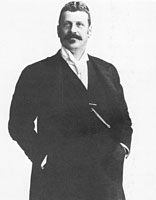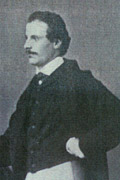Josef hoffmann
homes of the wittgensteins
JUNE 16–SEPTEMBER 2, 2002
The Wittgenstein Family
During the second half of the nineteenth century the Wittgensteins ranked amongst the most influential families in the Austro-Hungarian monarchy. Apart from their leading role in the iron and steel industries, they counted among their members musicians, such as the one-armed pianist Paul Wittgenstein; physicians; and one of the most significant philosophers of the twentieth century, Ludwig Wittgenstein. Descendants of a well-respected Jewish family from Germany, the Wittgensteins, whose surname was originally Mayer, converted to Protestantism in the mid-nineteenth-century and moved to Vienna in 1859.
The economic and social rise of the Wittgenstein family in its first generation in Vienna took place during a phase in which Vienna also blossomed artistically. In 1898 Karl Wittgenstein, a trained engineer who possessed the gift of combining the capabilities of the technician with those of the businessman, retired at the age of fifty-two from active leadership of the firm he had created. Freed from the heavy pressure of his work, he turned to the promotion of the new Viennese art scene, in addition to continuing his longtime charitable activities. In 1897 a group of the most progressive young Viennese artists including, among others, the painters Gustav Klimt and Koloman Moser, as well as the architects Josef Maria Olbrich and Josef Hoffmann, founded the "Vereinigung bildender Künstler Österreichs - Secession" ("Association of Austrian Artists - Secession"). In 1898 Wittgenstein enabled, by means of his financial pledges, the construction of their exhibition and association building, the Secession. Designed by Olbrich, it remains to this day an architectural symbol of the artistic rebirth of Vienna around 1900.
It was likely Karl Wittgenstein's older brother Paul -- a lawyer and an artistic individual -- who first introduced Karl to the new and burgeoning creative potential in Vienna. Paul Wittgenstein, extremely given over to the arts, was himself a talented portraitist and draftsman who had grown up in a household enamored with music, theater, and literature, a household that knew Johannes Brahms, Pablo Casals, and the Rosé Quartet as close friends and had taken in the violin virtuoso Joseph Joachim as a foster son and sponsored his training under Felix Mendelssohn-Bartholdy.
Paul became one of the first to commission Josef Hoffmann when he asked him to remodel a small farmhouse in Lower Austria in 1899, the so-called "Bergerhöhe." When Johanna Wittgenstein married the physician Johannes Salzer in 1902, her father, Paul Wittgenstein, gave her as part of her dowry an apartment designed by Josef Hoffmann in Vienna's sixth district at Gumpendorferstraße 8. In 1905, Hermann, Paul Wittgenstein's son, married Lydia Fries and in 1906 was also given an apartment in town done chiefly in black and white by Hoffmann and the Wiener Werkstätte at Salesianergasse 7 in the third district. On the occasion of the wedding of Karl Wittgenstein's daughter, Margarethe, to the American industrialist scion and chemist Jerome Stonborough and the couple's relocation to Berlin, her father had an apartment there furnished according to designs by Josef Hoffmann and Koloman Moser. In 1916 and 1917 Paul Wittgenstein had another apartment at Friedrich-Schmidt-Platz 6 in the eighth district of Vienna decorated in striking neo-classical and Biedermeier-inspired character by Hoffmann and the Wiener Werkstätte.
In each of these cases, Hoffmann's designs for the private interiors had to be fitted into existing older architectural shells. The same held true for Karl Wittgenstein's hunting lodge, Hochreit, which was outfitted by Hoffmann in 1907 and contains stunning interior surprises. A final project, the most lavish and expensive object ever produced by the Wiener Werkstätte, was purchased in 1908 at the Wiener Kunstschau (Vienna Art Show) by Karl Wittgenstein for his town palace on Alleegasse. For 25,000 crowns he acquired a vitrine with a solid silver body and decorated with enamel and moonstones that was designed by Carl Otto Czeschka -- though it was also mistakenly stamped with Josef Hoffmann's mark. This piece marks the completion of the stylistic change begun in the Wiener Werkstätte's aesthetic in 1907 toward more decorative, highly ornamented work and concludes Hoffmann's career as one of the Wittgensteins' most inspired, famous, and certainly favorite designers.
Karl Wittgenstein
Paul Wittgenstein, 1919


